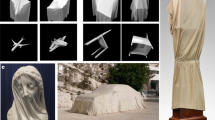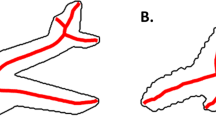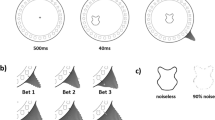Abstract
ONE of the most remarkable characteristics of the human visual system is its ability to perceive specific three-dimensional forms in single two-dimensional contour images. This has often been attributed to a few general purpose and possibly innately specified shape biases1–6, such as those favouring symmetry and other structural regularities (Fig. 1). An alternative approach proposed by the early empiricists7–10 and since tested11 suggests that this ability may also be acquired from visual experience, with the three-dimensional percept being the manifestation of a learned association between specific two-dimensional projections and the correlated three-dimensional structures. These studies of shape learning have been considered inconclusive, however, because their results can potentially be accounted for as cognitive decisions that might have little to do with shape perception per se. Here we present an experimental system that enables objective verification of the role of learning in shape perception by rendering the learning to be perceptually manifest. We show that the human visual system can learn associations between arbitrarily paired two-dimensional pictures and (projectionally consistent) three-dimensional structures. These results implicate high-level recognition processes in the task of shape perception.
This is a preview of subscription content, access via your institution
Access options
Subscribe to this journal
Receive 51 print issues and online access
$199.00 per year
only $3.90 per issue
Buy this article
- Purchase on Springer Link
- Instant access to full article PDF
Prices may be subject to local taxes which are calculated during checkout
Similar content being viewed by others
References
Koffka, K. Principles of Gestalt Psychology (Harcourt Brace, New York, 1935).
Kohler, W. Physical Gestalten (reprinted in A Sourcebook of Gestalt Psychology) (ed. Ellis, W. D.) (Humanities, New York, 1920).
Hochberg, J. & McAlister, E. Exp. Psychol. 46, 361–364 (1953).
Attneave, F. & Frost, R. Perception Psych. 6, 391–396 (1969).
Kanade, T. Artificial Intelligence 17 (1–3), 409–460 (1981).
Fischler, M. A. & Leclerc, Y. G. Proc. DARPA Image Understanding Workshop (Morgan Kaufmann, San Francisco, CA, 1992).
Locke, J. An Essay Concerning Human Understanding (1690) (in The English Philosophers from Bacon to Mill) (ed. Burtt, E. A.) (Modern Library, New York, 1939).
de Condillac, E. B. Treatise on the Sensations (1754). In: Philosophical writings of Etienne Bonnot, abbe de Condillac. Translated by Franklin Philip and Harlan Lane. (Lawrence Erlbaum Associates, Hillsdale, NJ, 1982).
Hume, D. A Treatise of Human Nature (Everyman's, London, 1738/1956).
von Helmholtz, H. Helmholtz's Physiological Optics (1866/1911). Translated for mthe third edition (1909–1911) by J. P. Southwell (ed.), Rochester, New York: Optical Society of America.
Wallach, H., O'Connell, D. N. & Neisser, U. J. Exp. Psychol. 45, 360–368 (1953).
Wallach, H. & O'Connell, D. N. J. Exp. Psychol. 45, 205–217 (1953).
Ullman, S. The Interpretation of Visual Motion (MIT Press, Cambridge, MA, 1979).
Marr, D. & Nishihara, H. K. Proc. R. Soc. Lond. B 200, 269–294 (1978).
Rock, I. & Di Vita, J. Cognitive Psychology 19, 280–293 (1987).
Poggio, T. & Edelman, S. Nature 343, 263–266 (1990).
Tarr, M. J. & Pinker, S. Psychol. Sci. 2, 207–209 (1990).
Bülthoff, H. H. & Edelman, S. Proc. Natl Acad. Sci. USA 89, 60–64 (1992).
Miyashita, Y. Annu. Rev. Neurosci. 16, 245–263 (1993).
Stryker, M. Nature 354, 108–109 (1991).
Cavanagh, P. in Representations of Vision: Trends and Tacit Assumptions in Vision Research (ed. Gorea, A.) (Cambridge University Press, Cambridge, 1991).
Marr, D. Vision (Freeman, San Francisco, 1982).
Beymer, D. & Poggio, T. Science 272, 1905–1909 (1996).
Morgan, M. J. Molyneux's Question: Vision, Touch and the Philosophy of Perception (Cambridge University Press, Cambridge, 1977).
Ames, A. Psychol. Monogr. 65, 1–32 (1951).
Gregory, R. L. Perceptions as Hypotheses Ch. 9 (ed. Brown, S. C.) (Macmillan, London, 1974).
Author information
Authors and Affiliations
Rights and permissions
About this article
Cite this article
Sinha, P., Poggio, T. Role of learning in three-dimensional form perception. Nature 384, 460–463 (1996). https://doi.org/10.1038/384460a0
Received:
Accepted:
Issue Date:
DOI: https://doi.org/10.1038/384460a0
Comments
By submitting a comment you agree to abide by our Terms and Community Guidelines. If you find something abusive or that does not comply with our terms or guidelines please flag it as inappropriate.



